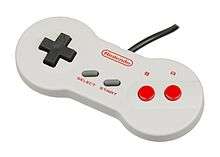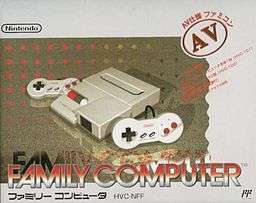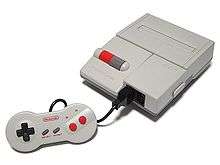Nintendo Entertainment System (Model NES-101)
|
The NES-101 control deck alongside its similarly redesigned NES-039 game controller. | |
| Manufacturer | Nintendo |
|---|---|
| Type | Video game console |
| Generation | Third generation |
| Retail availability | October 15, 1993 - 1995 |
| Media | ROM cartridge ("Game Pak") |
| CPU | Ricoh 2A03 8-bit processor |
| Graphics | Ricoh 2C02 |
| Controller input | 2 controller ports |
| Predecessor | Nintendo Entertainment System NES-001 |
| Successor | SNES Mini |
The NES-101 model of the Nintendo Entertainment System (informally known as the NES 2, the top-loading model, or simply the Top Loader) is a compact, top-loading redesign of the original Nintendo Entertainment System video game console released by Nintendo in 1993.
Nintendo marketed the NES-101 model as the Nintendo Entertainment System Control Deck, exactly the same as the original NES-001 model, only with a "new design" logo on the packaging. It retailed in North America for $49.99 USD (equivalent to $83.39 in 2016).[1] This was at a significantly lower price than the already released Super Nintendo Entertainment System. The NES-101 model is stylistically similar to the HVC-101 model of the Family Computer, which was released in Japan at roughly the same time, but differed in several ways. The NES-101 controller design is very similar to the Super NES controller. The major differences are that it has two face buttons instead of four, no L and R shoulder buttons, and is thinner in the middle. This controller, due to its shape, is often nicknamed the "dogbone" or "doggie" controller.
Control Deck (model NES-101)

The external appearance of the NES was greatly overhauled and restyled to align its looks to the North American Super Nintendo Entertainment System and to address a number of commonly cited ergonomic problems of the original NES-001 model. The case design was by Lance Barr, who also designed the NES-001, the SNS-001 and the SNS-101.[2] The power and reset buttons, while never a problem with the original design, now matched the curvature of the new look. The NES-101 does not have an LED power light to indicate the unit is on, as the original NES-001 and SNS-001 included.
The most obvious change in the redesign was the removal of the cartridge-loading system that caused trouble in maintenance and game-swapping when using the NES-001 model. In that system, the user had to first open the lid of the case, slide in the cartridge, then press it down. The large space inside allowed plenty of room for dust to settle and the contact heads were almost impossible to access and clean without disassembling the system or using the official cleaning kit. Wear and tear was another problem; with continued use, the precision of the mechanism deteriorated and the user would have to poke and nudge at the cartridge to move it to a position that would be read correctly. The NES-101 returned to the standard top-loading method, used by almost all cartridge systems before and since for its ease and reliability.
The design of the game controllers was changed. These were officially known as NES-039 model controllers and informally known as "dogbone" controllers. They were packaged with the system and also sold separately. The controllers were restyled to resemble the SNES controller, with rounded edges that fit more ergonomically in the hands than the old rectangular design (NES-004). The NES-039 model controller does not fit in R.O.B.'s controller slot because of this ergonomic change. The A and B buttons were also set at an angle to mimic the SNES controller as well as provide better ergonomics. The original NES-004 controllers and the NES-039 controllers are interchangeable between the original NES-001 model and the NES-101 model, as they use the same controller ports.
The 10NES authentication chip was completely removed from the system in an effort to eliminate the blinking red power light problem associated with it in the original NES. The removal of the 10NES chip also allows the system to play games that are unlicensed and/or from different regions such as Europe, something NES-001 systems cannot do without a hardware modification. A minor side-effect is that Nintendo World Championship will not work properly since it needs to know when the console is reset in order to go back to the menu. This signal is only provided by a working 10NES on official hardware.
The RCA composite video output and audio jacks were removed from the system as well; an RF connection is the only way to connect the system to a television unless one has the console modified to add composite output. The original video amplifier circuit path on the motherboard was poorly designed and created faint "jailbar" interference patterns in the game image.
Family Computer (model HVC-101)

The HVC-101 model of the Family Computer was a redesign of the original HVC-001 Family Computer video game console released by Nintendo in Japan in the early 1980s. While officially called the Family Computer, exactly the same title as the original, it was also marketed as the AV Famicom (AV仕様ファミコン Eibui Shiyō Famikon) or New Famicom to distinguish it from the original system. It was released in Japan on December 1, 1993 and retailed for ¥6800.[3] Like the original model, it is commonly referred to by the nickname "Famicom". It was stylistically similar to the NES-101 model released in North America at roughly the same time. It was produced until September 2003.[4]
The HVC-101 model was designed to address two major design flaws of the original HVC-001 model. The original HVC-001 featured hardwired game controllers; users who wished to add additional, specialized controllers were forced to make use of the deck's single expansion port (which was retained on the HVC-101). In bringing NES-style removable controllers to the HVC-101 model, Nintendo removed the microphone which had been originally included on the second controller in place of the "Start" and "Select" buttons. The microphone was originally intended to introduce extra functionality for certain games, but in practice, very few games had ever made use of it. The redesigned controllers have the Nintendo part number HVC-102 and are equivalent to the NES-039 controllers for the NES.[5] However, the HVC-102 controllers have much shorter cables than the NES-039 controllers.[6]

Secondly, the HVC-001 model featured audio/video output via RF modulator only. By the early 1990s, many Japanese television sets featured composite input jacks. The HVC-101 replaced the HVC-001's RF output connector with the same AV connector used in the Super Famicom, thus the name AV Famicom. This represented the biggest difference between the Japanese HVC-101 and the North America NES-101, which included only RF modulator output functionality (even though the original NES-001 had composite as well as RF modulator outputs). However, Nintendo sold an external RF modulator (HVC-103) for those who wished to connect their HVC-101 to a TV which lacked a composite video input. In an unusual move, Nintendo did not package an AV cable or AC adapter with the HVC-101, which either had to be purchased separately or shared with a Super Famicom.
The HVC-101 also featured a slightly different case design from the NES-101 in order to remain compatible with the Family Computer Disk System, as the area around the cartridge slot of the HVC-101 is flat rather than convex. This allows users to insert the large RAM Adapter cartridge required to use the Disk System accessory.
Console revisions
There are two known revisions of the NES-101; both have redesigned circuit boards that improve video output quality. The first has a Nintendo AV multi-out port (the same used in the Super NES, Nintendo 64, and GameCube) that replaces the RF jack completely.[7] The other looks exactly the same as the rest with the RF video output jack and channel select switch, but with excellent video output quality. These versions were replacements for those who sent their original NES-101 systems to Nintendo with a poor quality video complaint.[8][9] These models are extremely rare as they mostly came as replacement units from Nintendo,[10] but the revised AV model was also found in stores such as Meijer[11] and Radio Shack.[12]
See also
References
- ↑ http://www.nintendocosmos.com/nes_info.htm
- ↑ Chad Margetts & M. Noah Ward (May 31, 2005). "Lance Barr Interview". Nintendojo. Retrieved March 2, 2013.
- ↑ "HVC-101". Retrieved February 21, 2009.
- ↑ Niizumi, Hirohiko (May 30, 2003). "Nintendo to end Famicom and Super Famicom production". GameSpot. Retrieved January 11, 2014.
- ↑ "HVC: Family Computer (Famicom)". Retrieved February 8, 2010.
- ↑ "Nintendo AV Famicom (HVC-101)". i64X. 2012. Retrieved January 11, 2014.
Cords on the newer controllers are also slightly longer than those found on the original Famicom, though still much shorter than North American NES cables.
- ↑ "AV Top Loader". Retrieved December 28, 2009.
- ↑ "GameTechUS's rare RF redesigned circuit board". Retrieved June 1, 2010.
- ↑ http://www.nintendoage.com/index.cfm?FuseAction=Users.Photos&User=Dain&Album_ID=295#id295
- ↑ "Nes Toploader with AV Output". Retrieved December 30, 2009.
- ↑ "Nes Toploader with AV Output". Retrieved March 9, 2014.
- ↑ "Nes Toploader with AV Output". Retrieved March 9, 2014.
External links
![]() Media related to Nintendo Entertainment System (NES-101) at Wikimedia Commons
Media related to Nintendo Entertainment System (NES-101) at Wikimedia Commons

